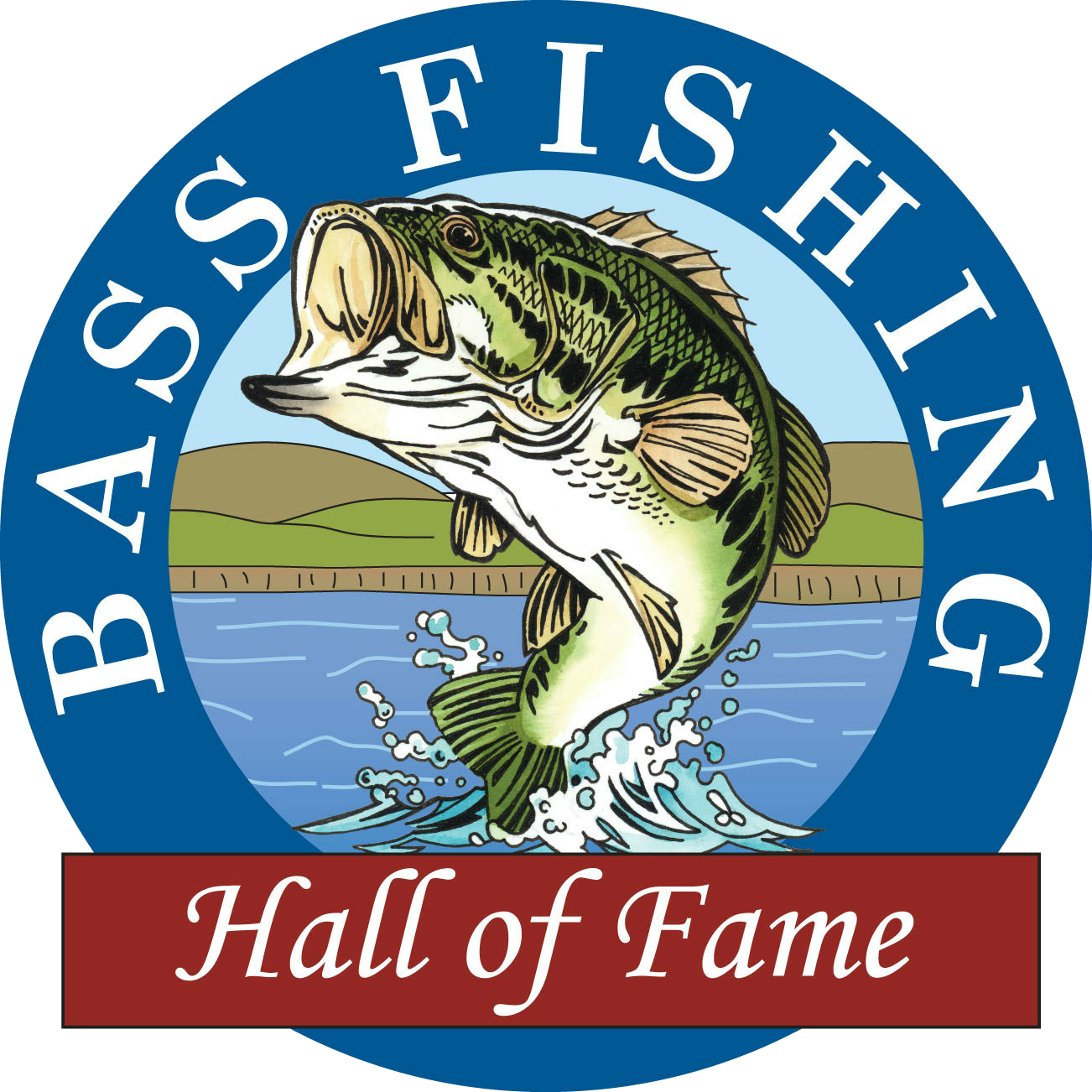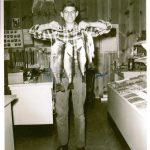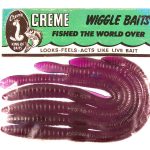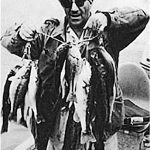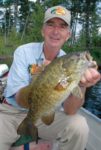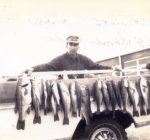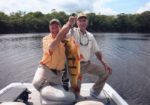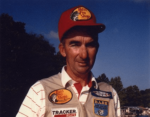Virgil Ward
Virgil, one of nine children, attended grade school in Easton and then moved with his parents to Amsterdam, Mo where he attended high school, graduating in 1931. On December 3, 1933 he was united in marriage to Cleda Irene Thornbrugh and to this union, four children were born. He was a member of the Church of God (Seventh Day). Virgil began his working career by selling, installing and servicing Delco 32 volt light plants after which he owned and managed Ward Electric Company. In 1950 he and his son began the Bass Buster Lure Company in Amsterdam. Virgil was a devout fisherman and built his reputation through several tournament victories including the 1962 World Series of Sport Fishing, the 1964 National Championship of Fresh Water Fishing and the 1964 Outdoor Writers and broadcasters National Fishing Tournament. By 1963, Virgil was writing a column that appeared in 455 newspapers, was host of a radio show on 200 stations and delighted viewers for years with his nationally syndicated television show “Championship Fishing” which was the #1 rated television show for 24 out of 27 years. He belonged to the Outdoor Writers Association, bass Club and American Federation of Television and Radio Association.
Virgil had a great sense of humor and a strong will.. all the way up to the end. He possessed a competitive nature, but was honest and giving. Outdoor pastimes included deer and quail hunting,, and fishing, of course….especially on the private lakes he built on his farm. He enjoyed the companionship of his bird dogs as well. Virgil, a devoted Christian family man, made memorable annual fishing trips to Canada. As one of the nation’s best-known fishermen, Virgil was an everyday person who became a legend, leaving precious memories to family and friends.
Virgil is survived by his wife of 70 years, Cleda Ward.
Virgil Ward
Elwood Lake (Buck) Perry – Widely acclaimed as the “father of structure fishing” – his theories changed the way very serious angler approached the underwater world.
His theories on structure fishing were based on his direct observations of fish behavior. As a lifelong fisherman, he repeatedly observed that fish travel both in schools and along predictable paths between deep and shallow water. These paths are determined by the bottom structure of the lake.
Buck Perry opened up our lakes and rivers to a different style of fishing than anyone before him had ever enjoyed. He was the first to talk about how weather affects the fish, specifically the “cold front”.
In 1946 he invented the Spoonplug lure in his North Carolina garage and the lure has remained on the market for more than five decades. Spoonplugs are lures (tools) specifically designed to find productive structure, locate fish, and make them strike.
Even before the days of sonar, Perry was using his Spoonplugs and trolling tactics to catch deep water and offshore bass that others did not even know existed.
He spent his life educating others about bass migrations, habitat and deep water methods. Perry published Spoonplugging: Your Guide to Lunker Catches in 1973 – considered one of the most influential fishing books ever written. He also published a nine-volume Home Study Series in 1981 and his bi-monthly newsletter, Buck Perry’s The National Spoonplugger, is still published today.
Though he passed away in 2005 at the age of 90, his Spoonplugging school is still a serious educational institution for anglers.
Buck Perry
Nick Creme (1910—1984) invented the modern plastic worm in 1949 while living in Ohio. Nick and Cosma Creme cooked up the perfect combination of vinyl, oils and pigments to produce a molded worm that not only looked and felt soft and alive, but also stayed that way when exposed to air over time. The first marketed worm was the Creme Wiggle Worm. It was sold by mail in 1951 at a cost of $1 for a pack of 5. When the product was shown at the Cleveland Sportsman’s Show, a distributor sold 9,600 in just a few days.
The demand soared and quickly outgrew the kitchen. That’s when the Creme’s set up a small manufacturing plant in Akron, Ohio.
In the late 50s, word of the soft plastic worm began to spread to bass anglers in the South. Crème decided to move his company into the center of the bass activity and built a plant in Tyler, TX. When professional anglers began winning early B.A.S.S. tournaments on Creme Scoundrels and Shimmy Gals, his business really took off.
Nick began to work with avid bass anglers who came up with many product innovations and rigging techniques. Creme was one of the first lure manufacturers to utilize a field staff network, and Nick used expert anglers nationwide to introduce his worms to other fisherman. He also became one of the first companies to sponsor a pro when, in 1967, Nick offered John Powell $18,000 a year to fish Creme worms.
Seldom does one individual in our industry have such a major impact. Nick Creme’s invention of the plastic worm in 1949 actually revolutionized bass fishing.
Nick Creme died in 1984, but today the tradition continues. Creme Lure Company continues to produce the original Scoundrel worm as well as new and innovative products.
Nick Creme
Charlie Campbell (1933—2020) After a 15-year career as a schoolteacher and basketball coach (including a State Championship and a Coach of the Year Award), Campbell opened a marine dealership in 1974 in Branson, Missouri. That same year, he won the B.A.S.S. Federation National Championship and placed fifth in the Bassmaster Classic.
In 1977, he went to work for Johnny Morris of Bass Pro Shops in Springfield, Missouri, where he helped design the Bass Tracker Boat.
Campbell’s fishing career started by guiding on Bull Shoals Lake in 1958 during summers and after school. He developed the “Charlie Campbell CC Spinner Bait,” and his successes in topwater fishing helped bring back the Zara Spook.
In addition to fishing five Classics, he won a total of 67 tournaments on a variety of trails. He has been inducted into the Drury College Sports Hall of Fame and the Missouri Sports Hall of Fame, and he was named an “Outstanding Missourian” by the state’s House of Representatives.
Mr. Campbell passed away April 19, 2020
Charlie Campbell
Tim Tucker (1957 – 2007)— During his 25-year career as an outdoor writer, Tim Tucker was easily one of the most prolific, influential and widely published journalists in the fishing world.
A senior writer for Bassmaster and B.A.S.S. Times magazines from the early 1980s, Tucker’s articles and photos were included in almost every issue of both publications. He also was published in Field & Stream, Outdoor Life, In-Fisherman and a host of other publications. He wrote syndicated outdoor columns for 33 newspapers, published a bimonthly newsletter on the business of bass fishing and co-hosted a radio program with angler and industry insider Gary Giudice for many years.
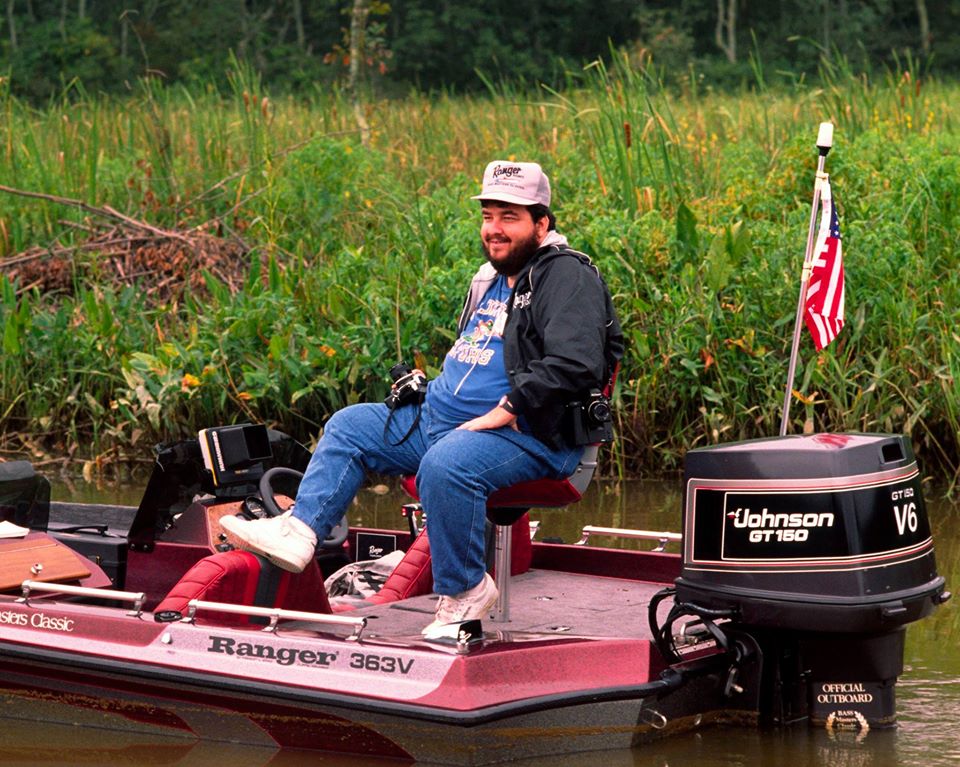
Tucker had a passion for writing that began in high school, when he won the Quill & Scroll national writing award for students. That was the first of more than 100 awards he received for his writing and photography over the years.
He got a job as a copy boy for his hometown newspaper, The Palm Beach Post, and worked his way up to outdoor writer. In that role, he developed a relationship with Roland Martin, the nine-time Bassmaster Angler of the Year who lived and worked at Clewiston, Florida, on Lake Okeechobee, an easy drive from West Palm Beach.
With Martin vouching for him, Tucker launched his freelance writing career.
“Once he got started, he really got rolling,” said Martin. “He came along at the perfect time for me at the pinnacle of my success. He chronicled all that.”
Tucker focused the first of his eight books on his friend: Roland Martin’s 101 Bass-Catching Secrets. Other successful titles include, Bill Dance on Largemouth Bass, Bill Dance on Crappie Fishing, Advanced Shiner Fishing Techniques, Diary of a Bass Pro: A Year on the Inside of Fishing’s Fast Track with Joe Thomas, Advanced Shiner Fishing Techniques, Secrets of America’s Best Bass Pros and More Secrets of America’s Best Bass Pros.
For two decades, Tucker attended as many professional tournaments on the B.A.S.S. circuit as he could, including those he was not assigned to cover. He valued the events as treasure troves of ideas and inspiration that would help weekend anglers catch more bass.
His articles helped launch the careers of several of the sport’s most successful pro anglers. He mentored several of them on how to build a career around fishing, and he led seminars for pros to teach them how to acquire, serve and keep sponsors.
Tucker was dedicated to the craft of journalism. He was an active member and a past president of the Southeastern Outdoor Writers Association (SEOPA), and he regularly helped other journalists make their way in covering the sport.
Tucker died in an automobile accident in Gainesville, Florida, in July 2007. He was 50 years old. Among the many eulogies from his friends in the sport and industry of bass fishing, pro angler Bernie Schultz of Gainesville captured the essence of his impact on bass fishing. “There will never be another Tim Tucker,” he said. “He helped shape the sport.”
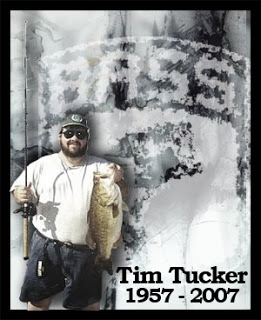
Tucker was posthumously awarded the B.A.S.S. Outstanding Achievement Award at the 2008 Bassmaster Classic in Greenville, S.C. The award was accepted by his wife, Darlene, and their twin children, Rachel and Kyle.
Tim Tucker
Steve Price has been a full-time writer and photojournalist since 1973 and a writer/photographer for Bassmaster since 1974. During his writing career, Price has sold more than 3,000 magazine articles, primarily about bass fishing, to such publications as: Field & Stream; Outdoor Life; Sports Afield; National Geographic; Rand McNally; Southern Living and many more.
Price served as Outdoor Editor for Southern Living magazine, which had a circulation of 3 million, from 1975-78. He was a syndicated newspaper columnist for 10 years (1986-96), a radio program producer/host (1990-1994) and is the author of five books about bass fishing.
His photography has been recognized both nationally and internationally and Steve Price has been a semi-finalist and finalist in the worldwide “Wildlife Photographer of the Year” competition sponsored by British Petroleum (nearly 20,000 entries annually). His photography has been used in books and promotions worldwide and by organizations such as: National Geographic Society; Reader’s Digest; Associated Press; Game Conservation International; Rocky Mountain Elk Foundation; General Motors; Toyota and the Brunswick Corp., among others.
In addition, Mr. Price has attended every Bassmaster Classic since 1976 as a press writer/photographer, having written about and photographed the legends of bass fishing during this time.
